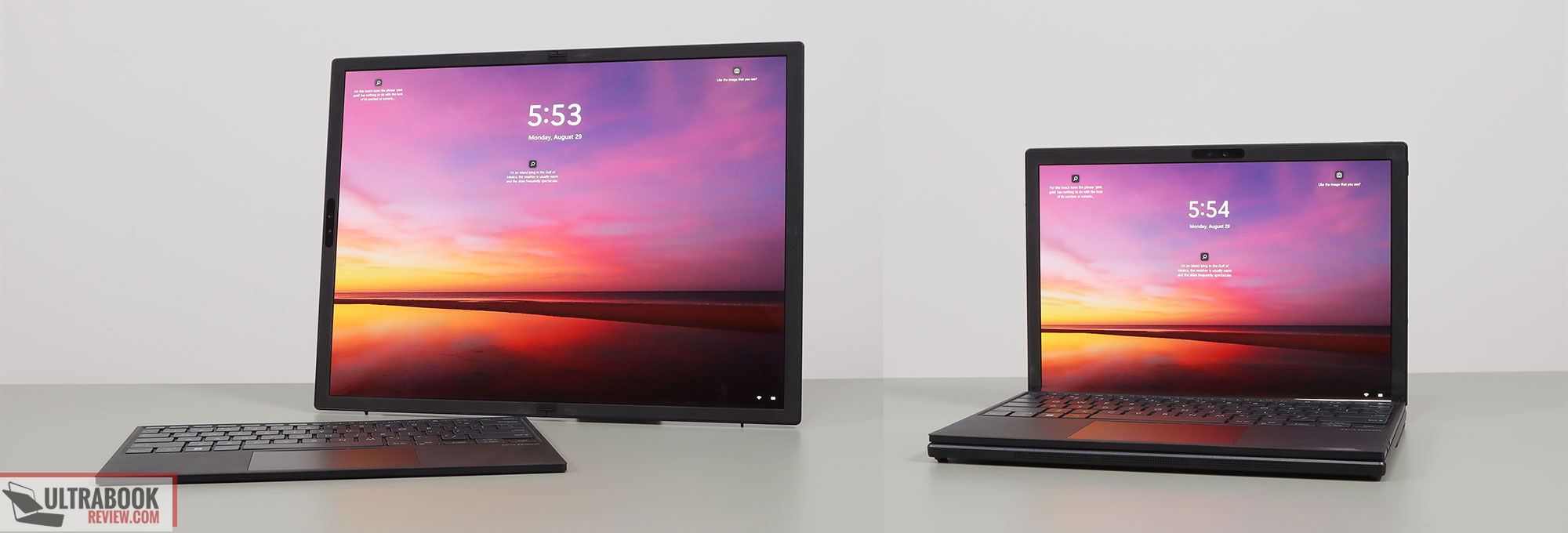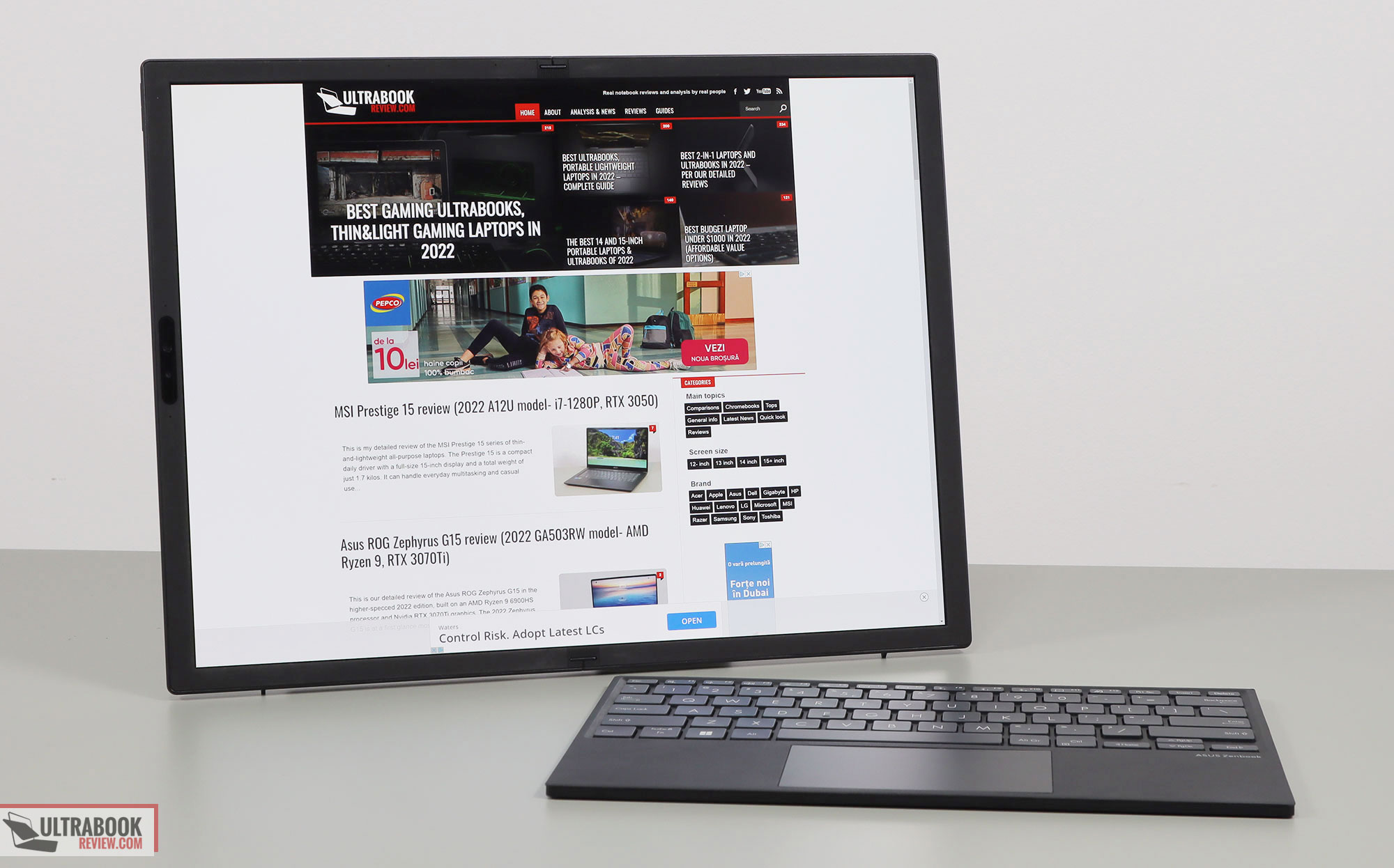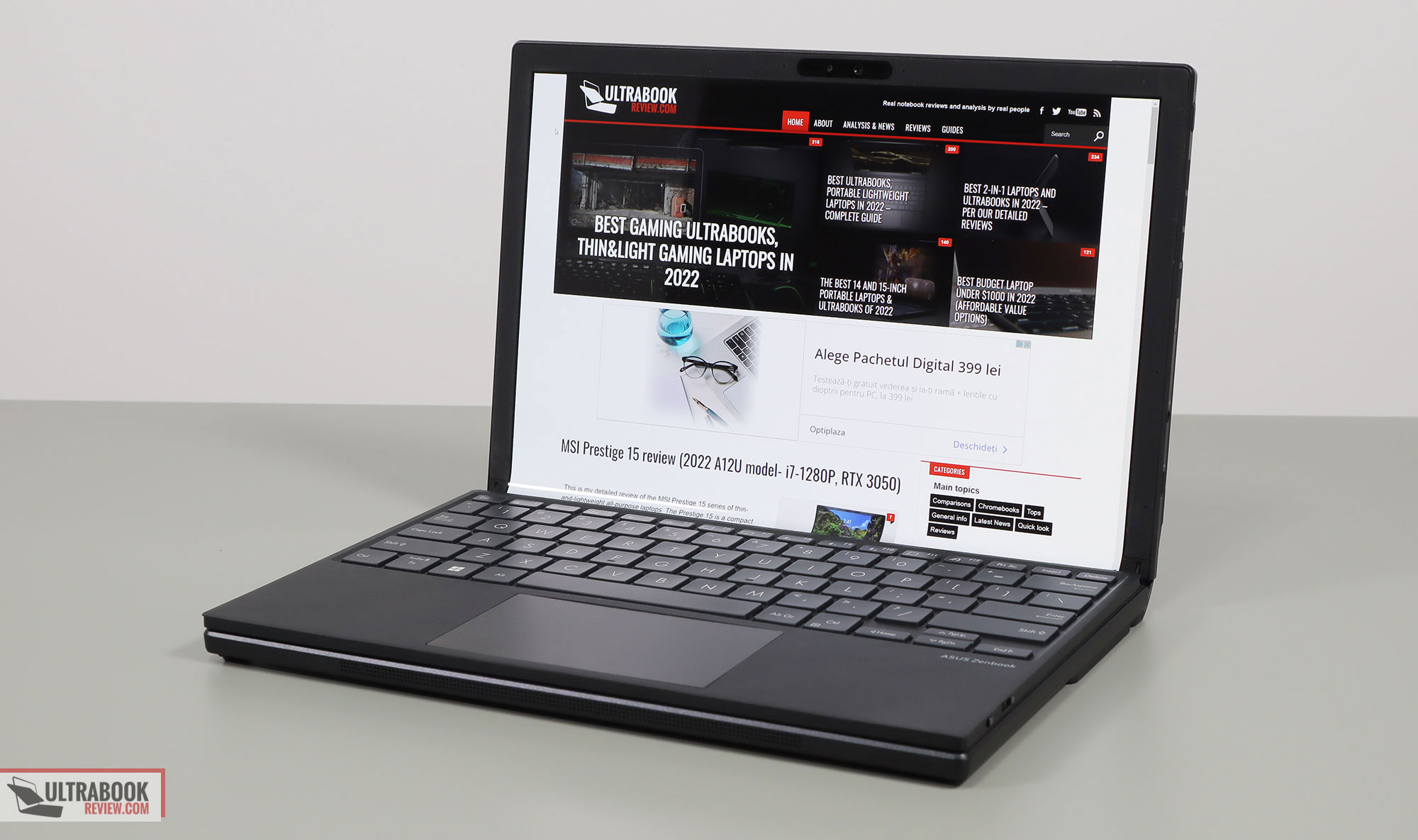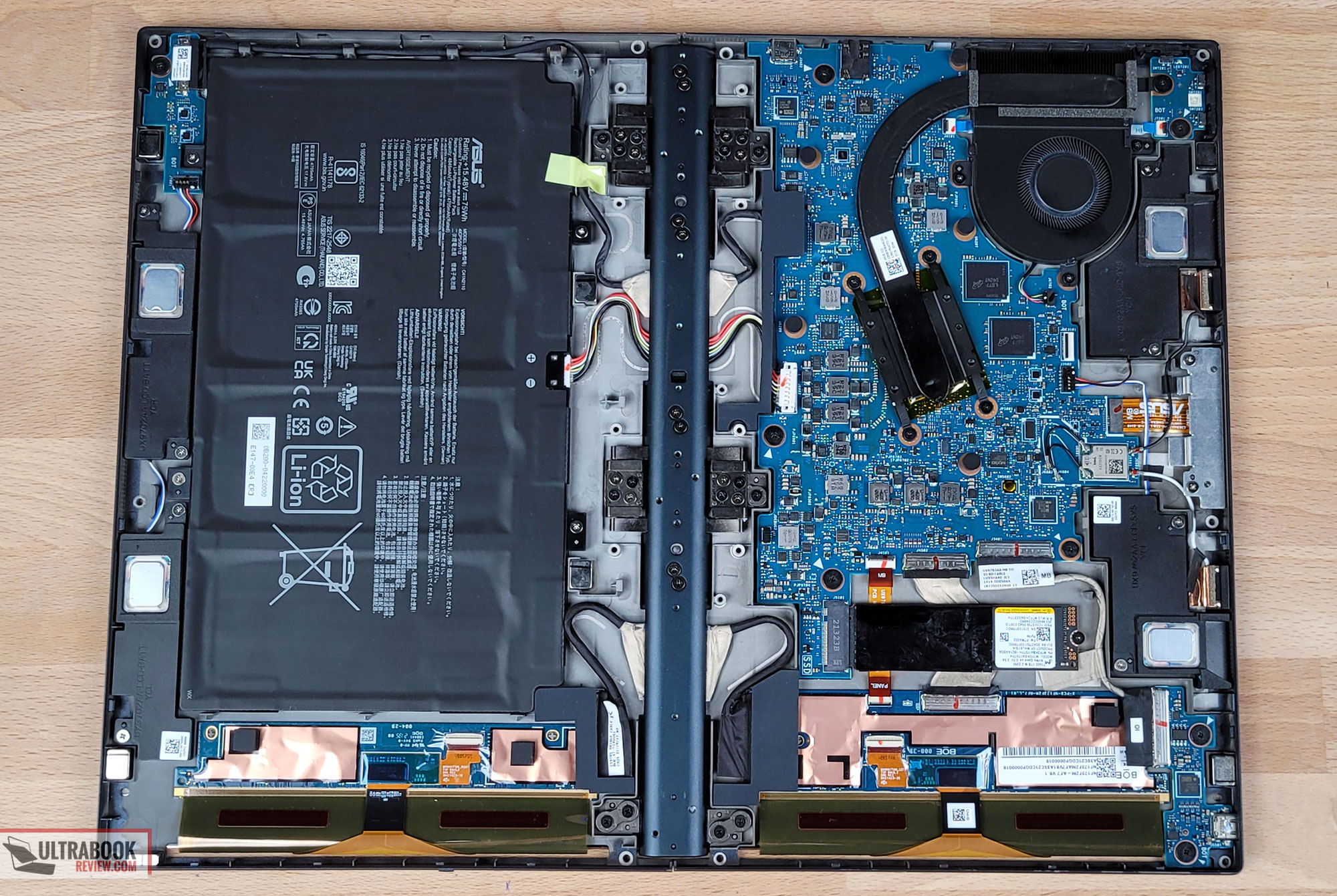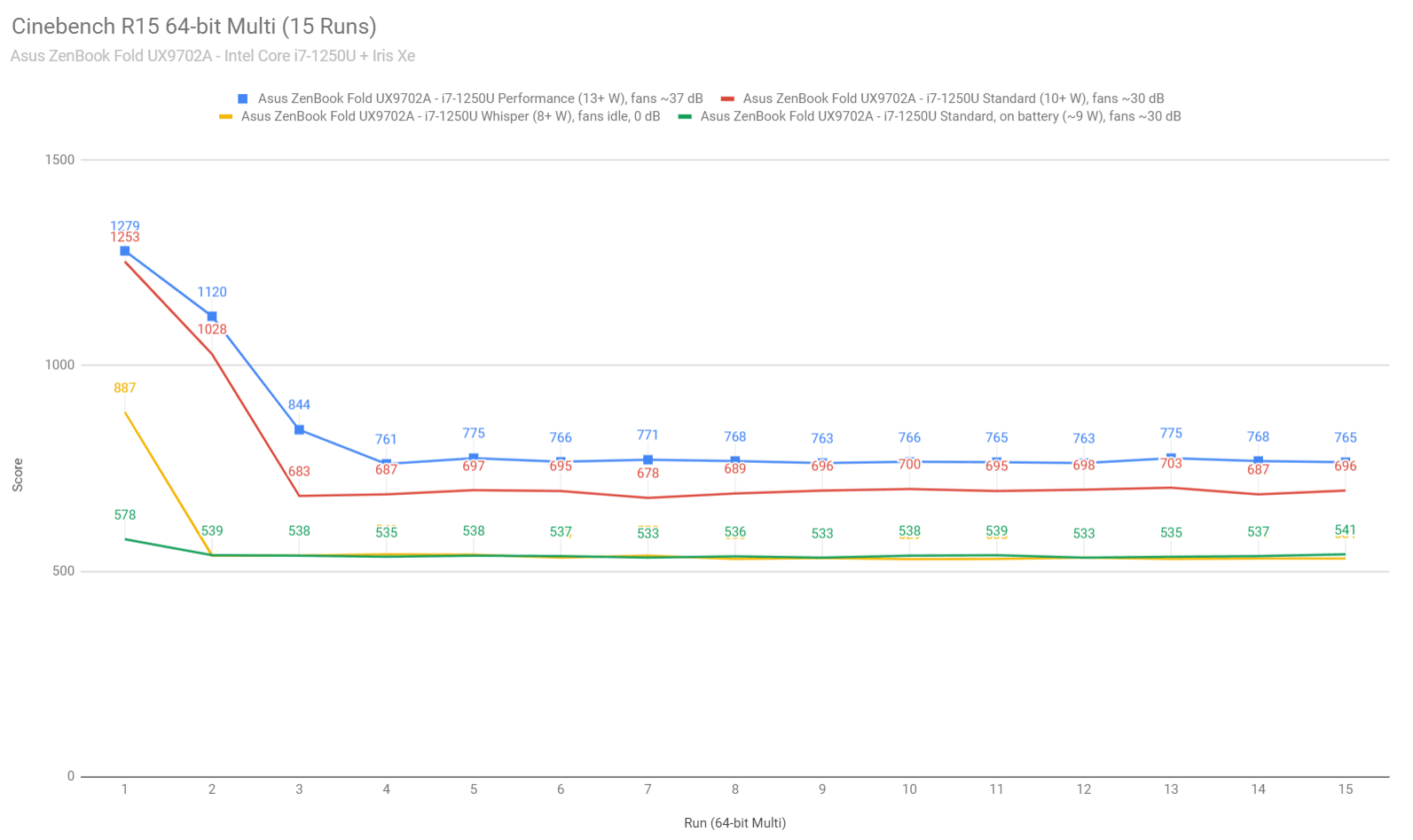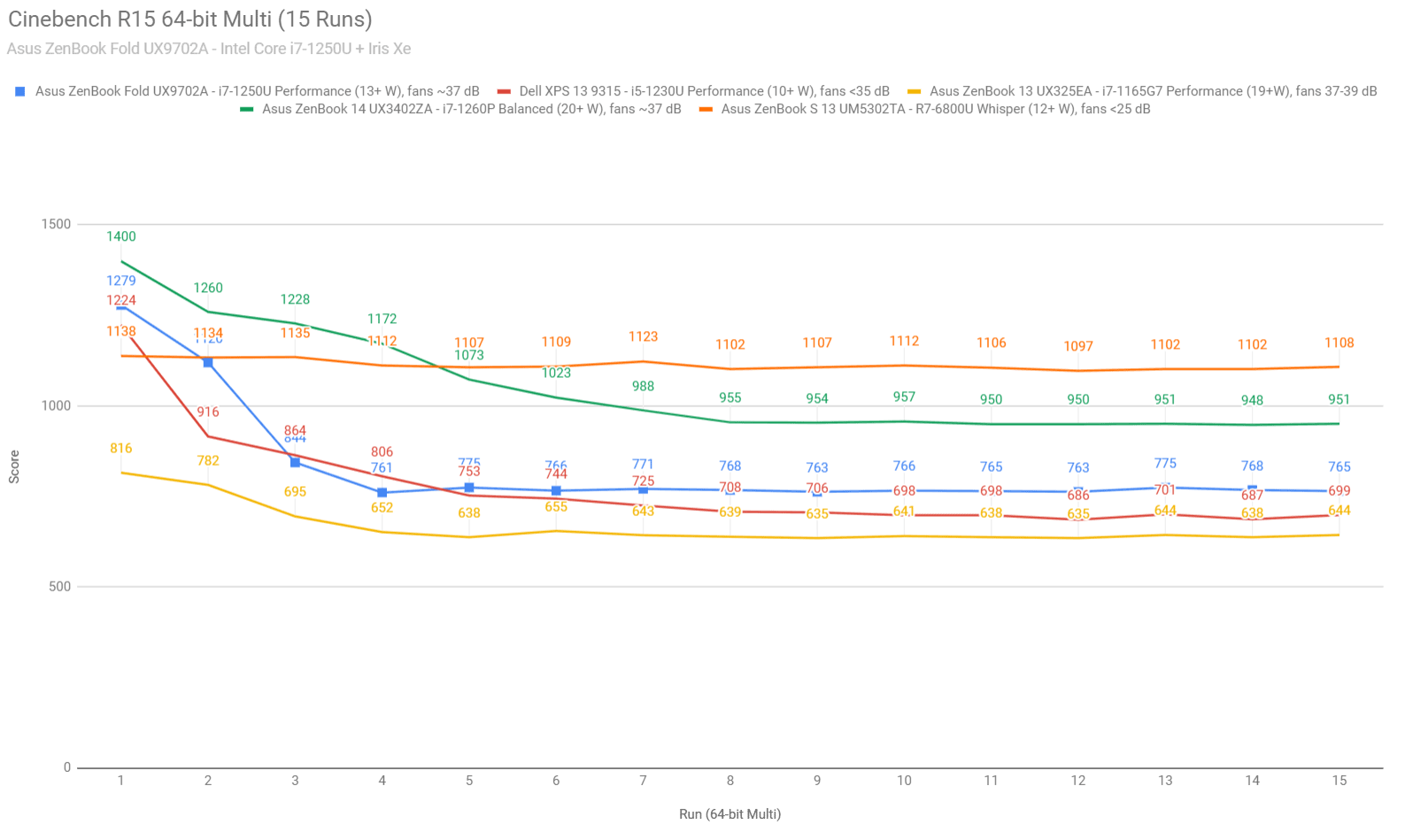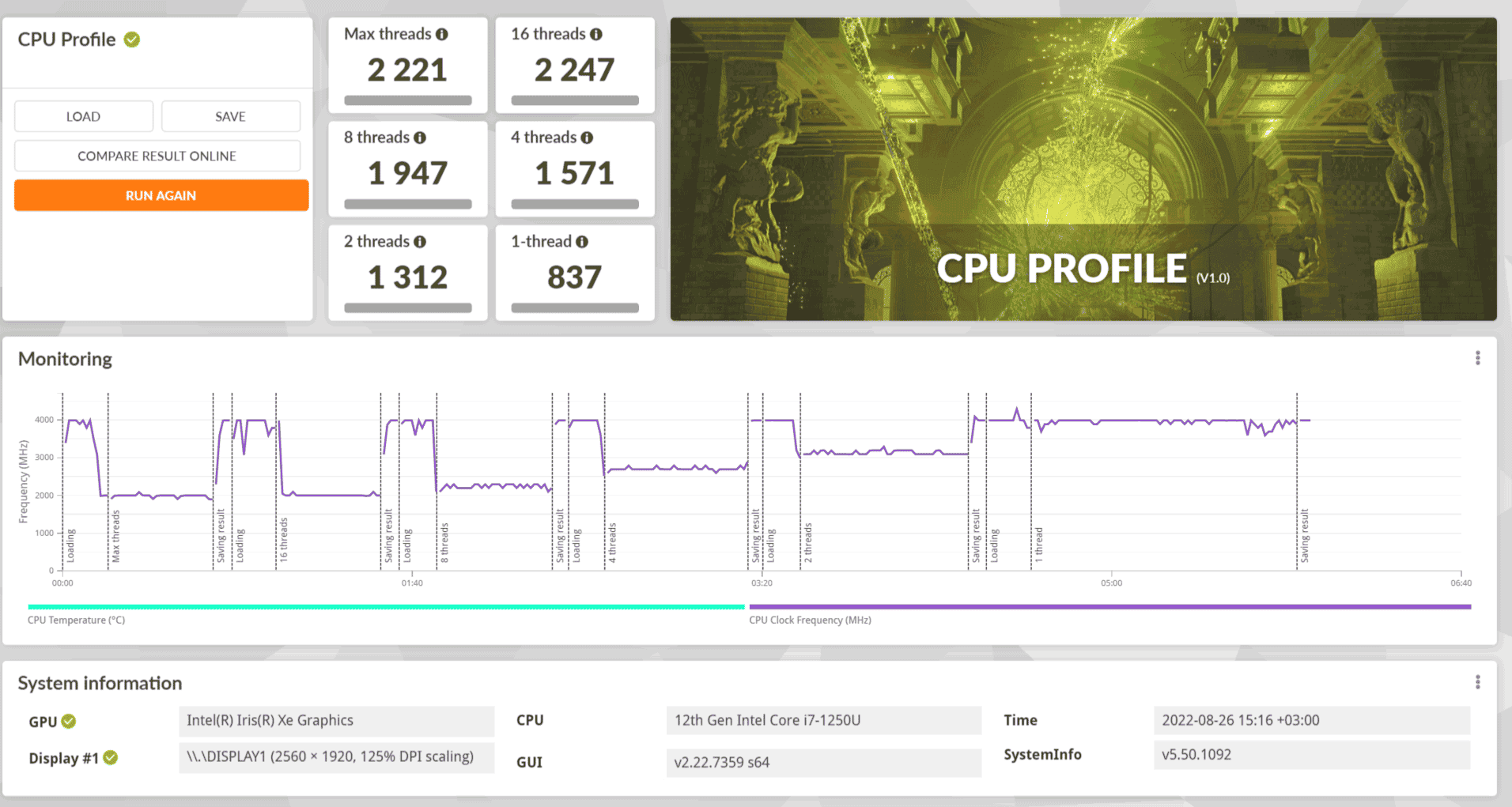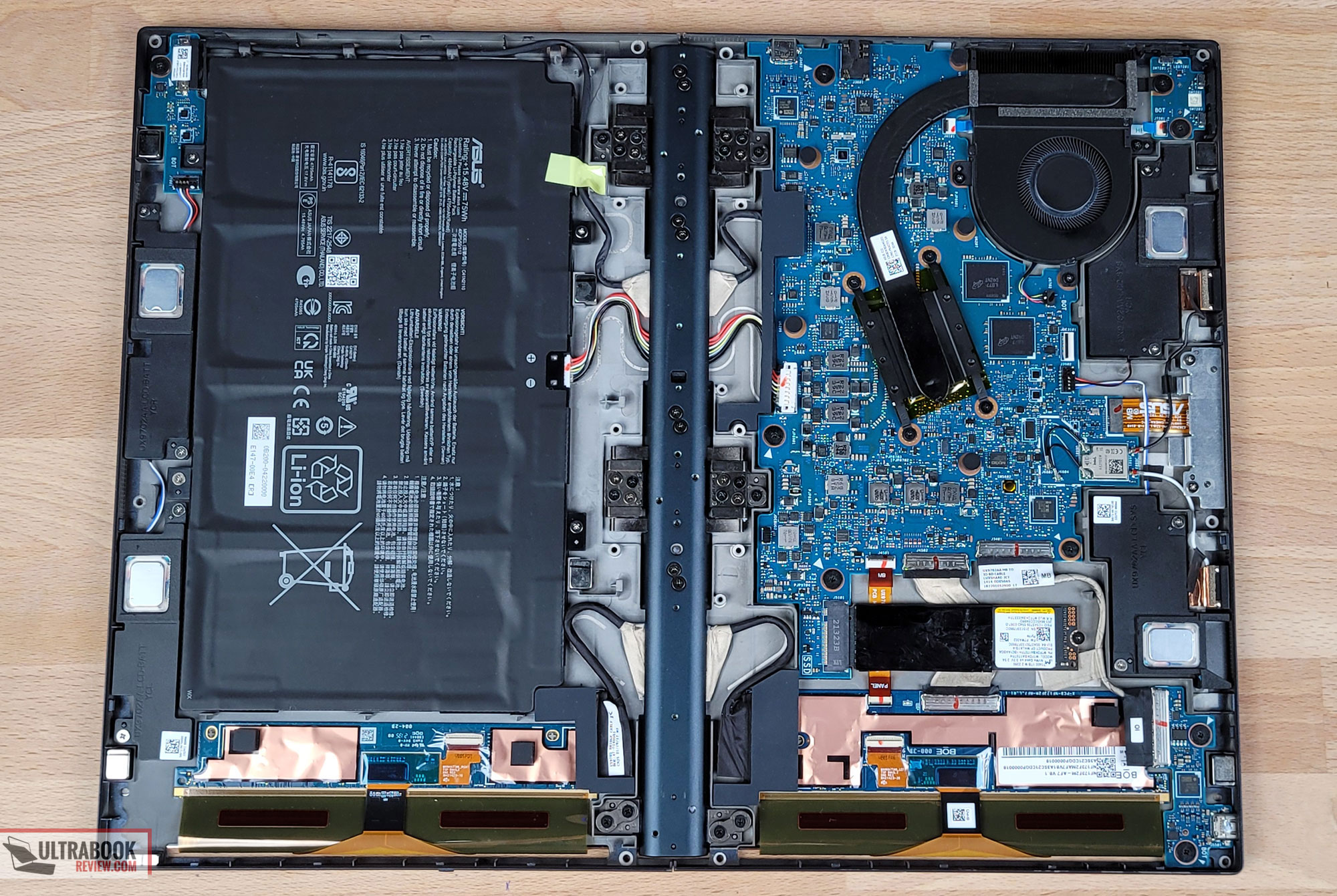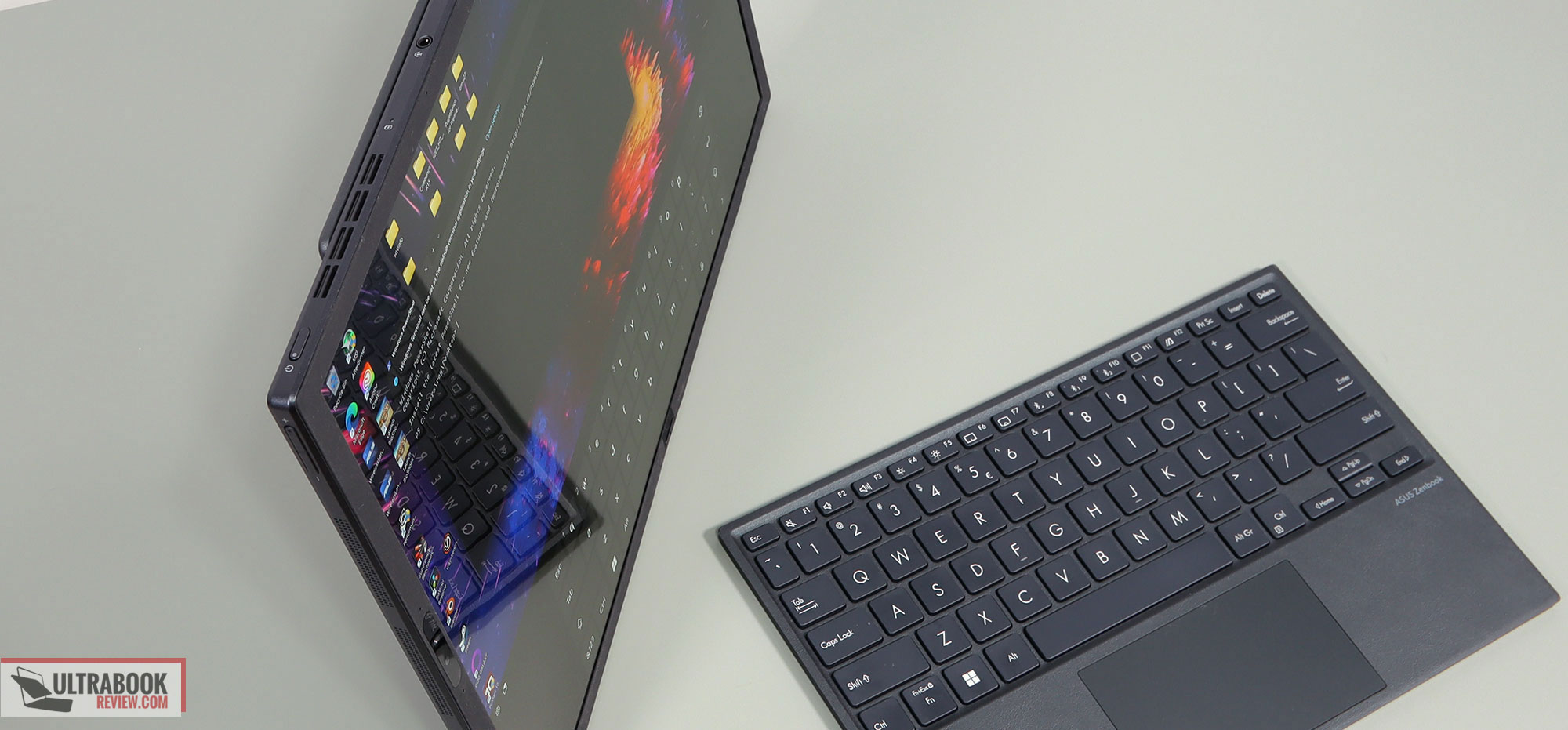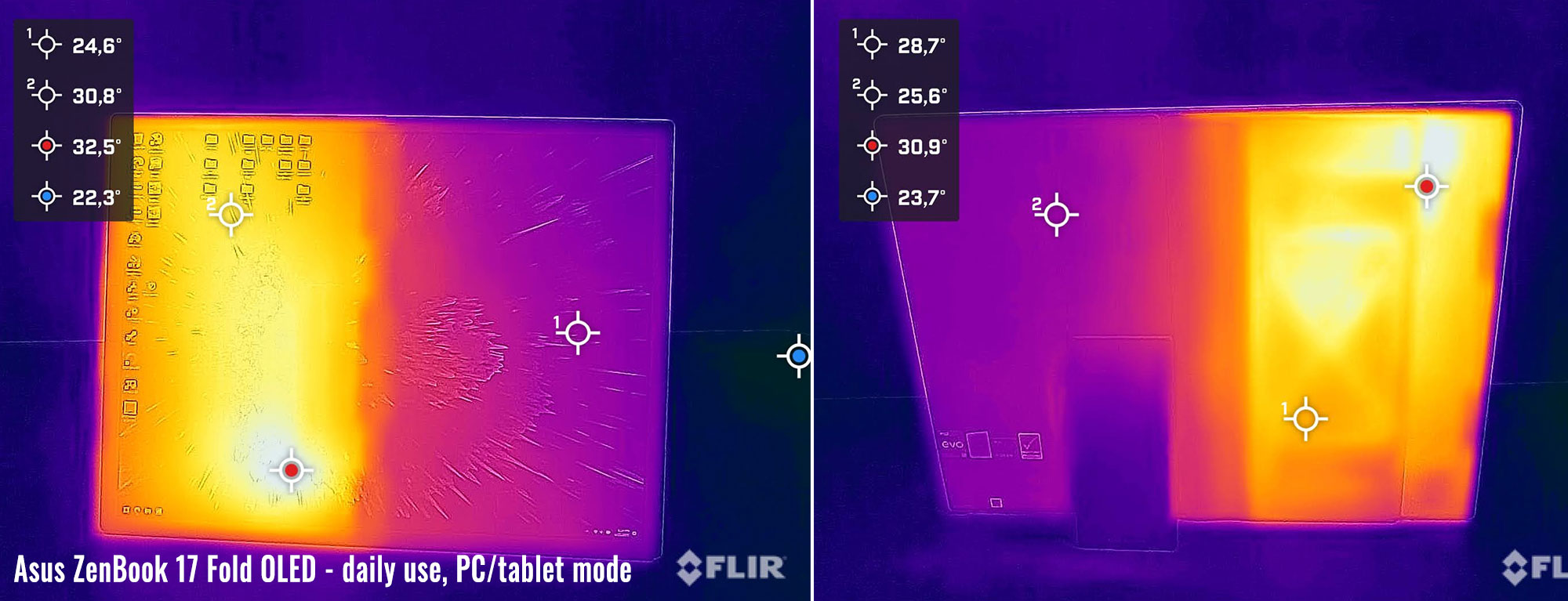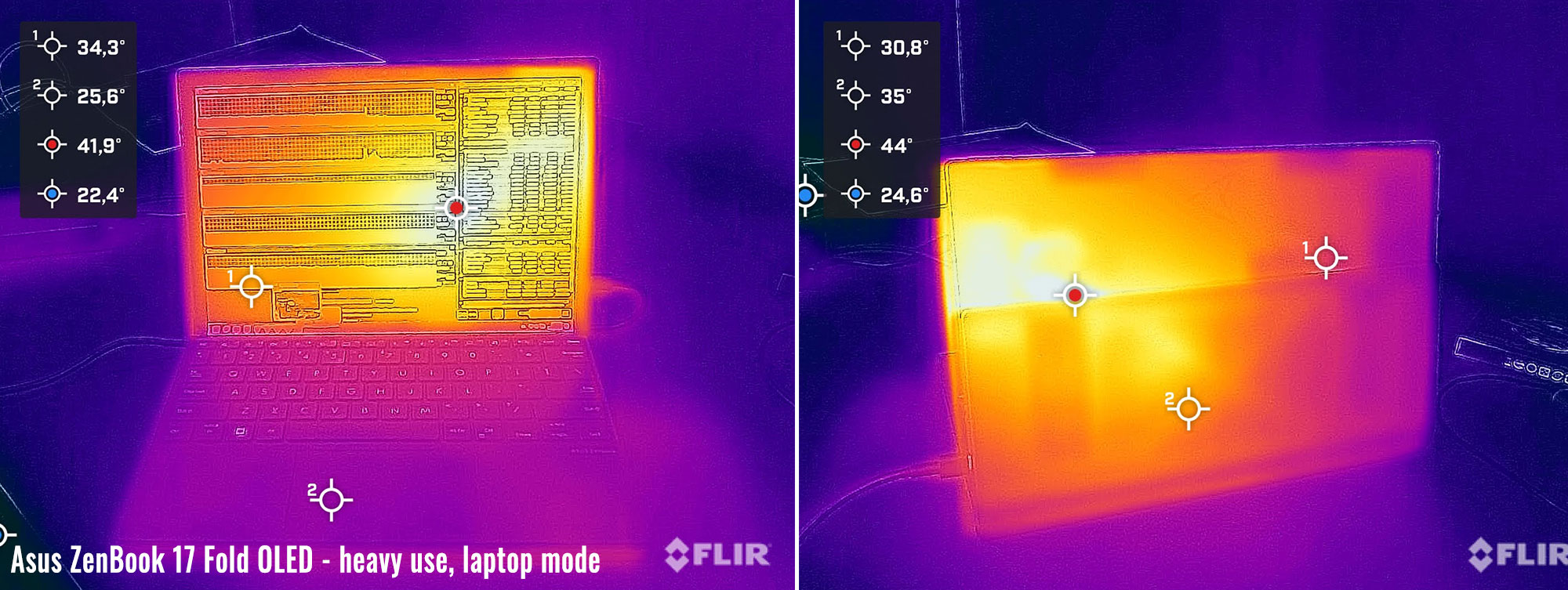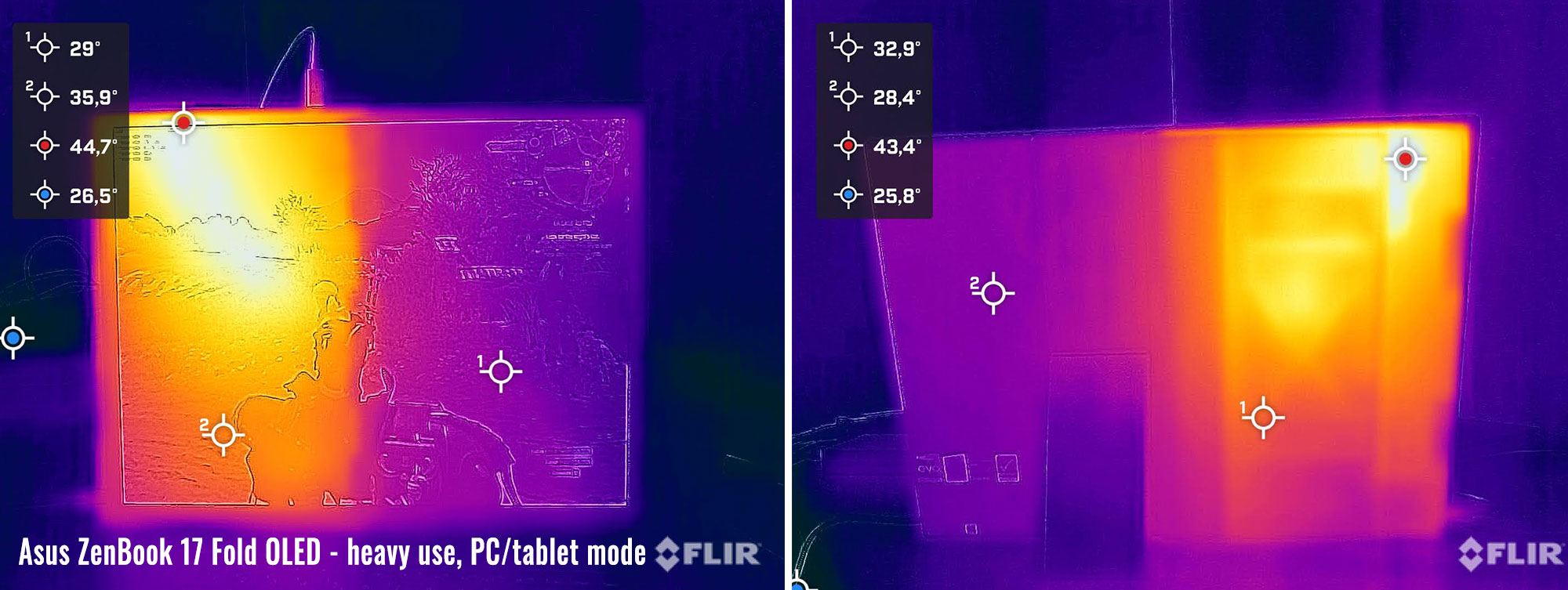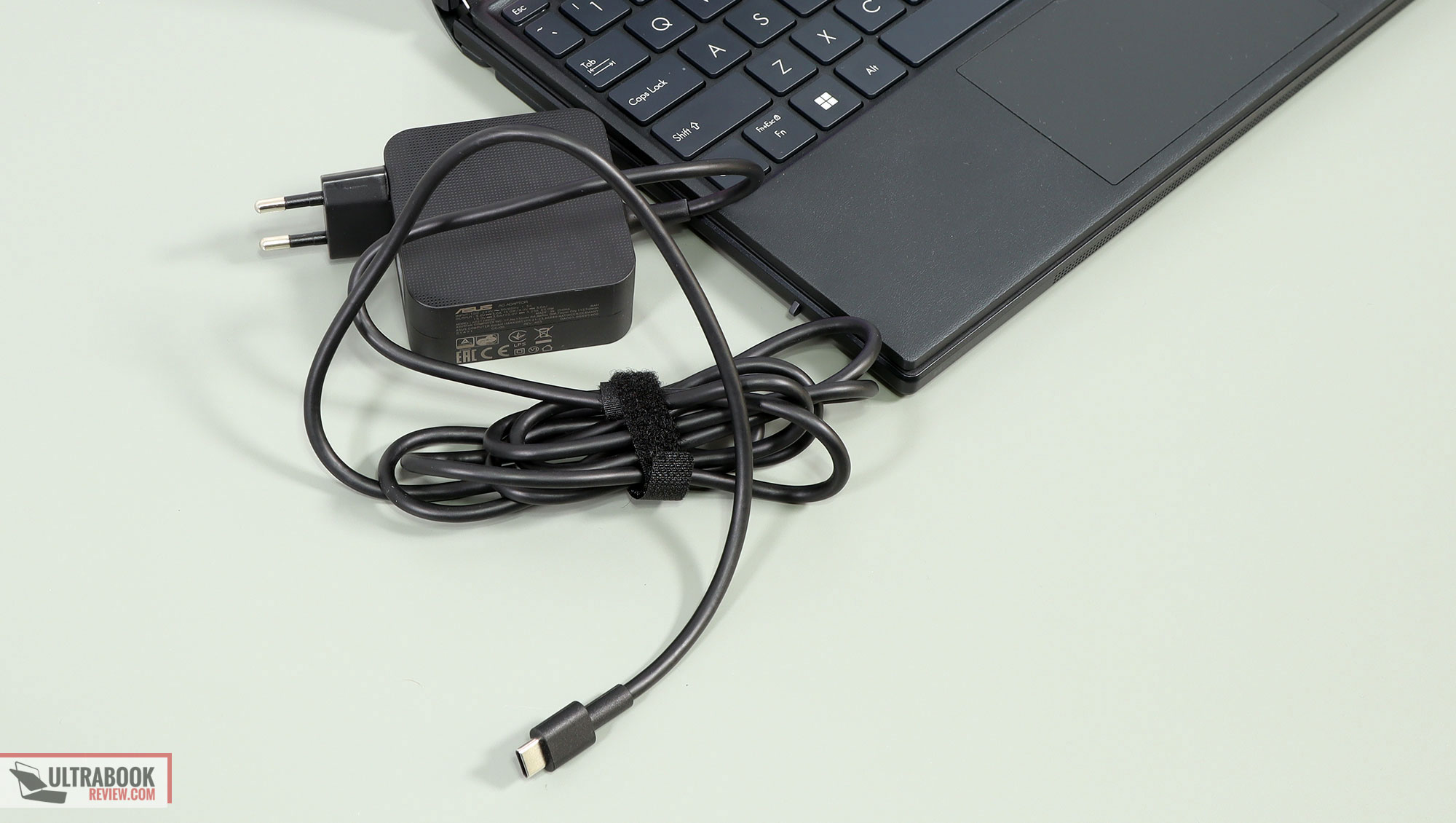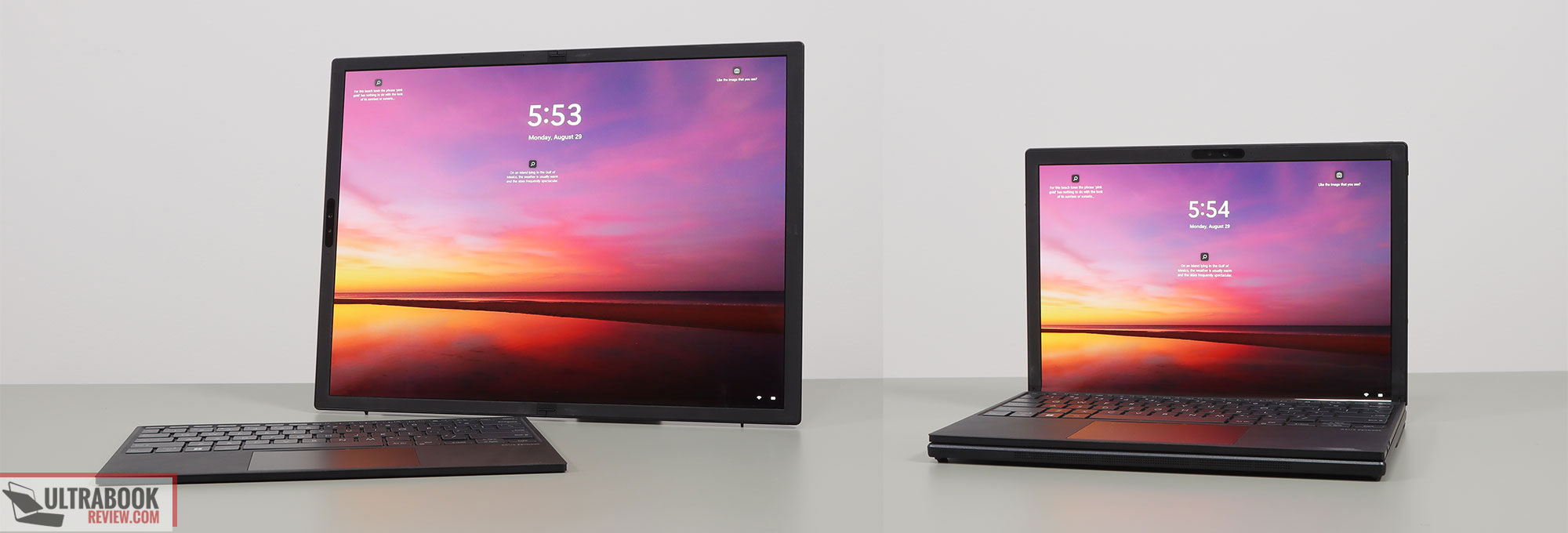
Asus ZenBook 17 Fold OLED review (foldable laptop, 2022 UX9702A model)
Asus presented the Zenbook 17 Fold OLED some months ago, and in meantime, I’ve got to spend the last two weeks with a final model and I can share my thoughts and impressions with you.
The laptop is not yet available in stores and is scheduled for somewhere around November, but Asus says that this review unit is the final design, with certain software aspects still to be further tweaked in the next months.
In a few words, the ZenBook Fold is a 17-inch 4:3 tablet that folds at the middle, into a laptop format. That means you can use it as a compact laptop (about the size of a modern 12.5-incher) with or without the included folio, or you can set it up on the desk and use it as a 17-inch all-in-one computer. There are also a few more formats to consider, and we’ll discuss them further down.
I was intrigued when this was first announced but didn’t get my hopes high on its real-life practicality, perhaps biased by my past experience with the original Lenovo X1 Fold from a few years ago. The technology has greatly improved in the meantime, though, both for the hardware and especially for the screen, and the fact that Asus went with a larger 17-inch format here makes the ZenBook Fold a lot more practical than I was imagining.
Of course, this device is surely not for everyone. First off, it’s prohibitively expensive at around 4000 USD/EUR MSRP, and price aside, it’s not as carefree or as capable as a regular modern ultraportable. Hence, the Fold targets tech enthusiasts with a hefty budget and a desire to own the latest laptop technology currently available, and, as long as you can afford it and understand and accept its limitations, this might make sense for you. Let me explain why.
Specs – Asus Zenbook 17 Fold OLED UX9702
| Asus Zenbook 17 Fold OLED UX9702A | |
| Screen | 17.3 inch, 2.5K 2560 x 1920 px 4:3 aspect ratio, 60 Hz, OLED, glossy, touch, BOE panel 500-nits peak, HDR400, 100% DCI-P3 color coverage |
| Processor | Intel Alder Lake 12th-gen U9, Core i7-1250U, 2C+8c/12T |
| Video | Intel Iris Xe, 96 EUs, up to .95 GHz |
| Memory | 16 GB LPDDR5-5200 (soldered) |
| Storage | 1x M.2 PCIe 4.0 x4 SSD (Samsung PM9A1), single M.2 2280 slot |
| Connectivity | Wireless 6E (Intel AX211), Bluetooth 5.2 |
| Ports | 2x USB-C 3.2 with Thunderbolt 4, audio jack |
| Battery | 75 Wh, 65W USB-C charger with quick-charging |
| Size | Tablet: 379 mm or 14.9” (w) x 287 mm or 11.32 (d) x 8.7-12.9 mm or 0.34-0.51” (h) Laptop: 288 mm or 11.33” (w) x 190 mm or 7.43 (d) x 34.4 mm or 1.35” (h) |
| Weight | 3.35 lbs (1.52 kg) tablet only, 4 lbs (1.82 kg) tablet+keyboard folio, plus .49 lbs (.22 kg) charger + cables, EU version |
| Extras | Bluetooth keyboard folio – non-backlit, 5 MPx camera with IR Hello, quad speakers, carry case included |
Here are the few modes explained, with dimensions for each case.
Design and daily-use experience
As mentioned already, the ZenBook 17 Fold is a 17-inch tablet that folds in half in the middle. The front face consists of the screen, surrounded by some thick edges at 10-11 mm all around. They get this rubberized texture and have the purpose of ensuring proper grip when using the device, as well as preventing your fingers or the keyboard folio from touching the display.
This is important, because the display is not covered in oleophobic glass as with other modern touch devices, but instead with a plastic layer, so it can fold. This layer catches smudges and fingerprints easily, and it can also scratch easier than glass. So you’ll want to treat this with the utmost care.
Furthermore, this display is rather difficult to clean up once it smudges, due to the somewhat catchy texture of the plastic film, but also because filth and dust tend to gather around the edges where the display meets the bezels. Hence, during my time with this Fold, I tried using the touch functionality as little as possible, just so I wouldn’t have to clean this off. You might argue that doesn’t make sense, as the touch functionality is one of the major selling points of the series, and that’s true. I just chose not to deal with the fingerprints.
This wasn’t that difficult because I don’t think this product is that useful in tablet mode. It’s just too big and heavy for that. Instead, I’ve used in mostly two ways: PC mode on the desk, and laptop mode with or without the keyboard folio.
Speaking of the size and weight, this is not quite your standard ultraportable design, as it’s both thicker and heavier than a regular ultrabook. The tablet and the folio add up to about 4.00 lbs combined.
For PC use, this is nearly perfect. Asus implemented an adjustable kickstand at the back and rubber feet at the base of the chassis, both allowing for good stability and practicality on the desk, at least when having it in Landscape mode. Portrait mode is complicated – it’s possible with the help of an extra cardboard kickstand included in the box, but I couldn’t quite figure out how the origami required to make it actually work. So I only used this in Landscape.
I find the large and beautiful screen awesome for daily use and productivity. The punchy speakers help as well, both when running some music in the background, or when streaming some movies in your spare time. The hardware inside this is a low-power Intel 12th-gen Core U, which feels responsive and snappy with daily multitasking, but mostly on the Performance profile that pushes more peak power. You will hear the fan from time to time in this mode. Instead, if you preffer a quieter fan or a fanless experience, this is only going to fare well with very basic tasks and little multitasking, otherwise, it won’t feel as responsive as other modern devices.
Of course, you should consider that my expectations of responsiveness are very high, as I normally use the latest and most powerful platforms and thus have little patience or understanding for any sort of lag or sluggishness. You, on the other hand, might not be quite as demanding as I am, and thus might find the everyday experience with this sort of device alright even on the other profiles. After all, this sort of 1250U hardware is about on-par with the kind of Intel hardware available in most ultrabooks in the past years, up to the popular i7-1165G7 from 2021 available in the Dell XPS or the Microsoft Surface Pro.
As a laptop, with the keyboard folio placed over the lower part of the screen, only half of the display is available for content. The whole thing is also rather thick in comparison to a modern ultrabook, but is still one of the most interesting mini-laptop experiences I’ve tried in a while. I especially like the 3:2 aspect ratio in this mode, and how the Windows taskbar looks over the rounded crease at the middle of the display.
For couch and casual use, I preferred using this without the folio, by activating the virtual keyboard and resizing it to my needs. That allows more usable space on the screen. Fingerprints are once more the downside of using this Fold in this way. I’ve added a picture of how this looked after a few hours of touch-use, just for reference. Of course, the smudges are not as visible with the screen on, but I still had to wipe it clean daily, which is not as easy as on an iPad or similar tablets with all-glass fronts.
Screen aside, Asus put much effort into making this feel like a premium-class computer. Magnesium alloys are used for the entire construction, so this feels sturdy and well made, while the exterior is made from a mix of metal, faux-leather and matte glass materials.
A sturdy chassis and a well-thought hinge system were required in order to allow for the screen to fold and open smoothly, especially as a lot more can go wrong on this sort of large product in comparison to a folding phone like a Galaxy Fold. The hinges are stiff and you need to apply a fair bit of force to open up and fold this, but the process feels OK once you got used to the idea that you can fold this in half and it won’t break. Asus mentions the design was tested to ensure 30.000+ open/close cycles, and most likely will last more. Any manufacturing issues should be covered by a relaxed warranty policy, to convince potential buyers to take the plunge with this sort of new format.
There are some warnings that Asus mentions to make sure you won’t damage the screen when folding it, but they’re more than logical to me. You should be careful not to press on the display itself, instead, apply force to the exterior edges of the metal frame. You should also be careful not to catch anything between the foldable parts, and position the keyboard folio in the designed way, as guided by the magnets.
Asus also implemented a bigger radius on the hinge, so that the screen will not tear up in the middle over time. This kind of design allows to sandwich the keyboard folio between the two screen parts when closing this up for transport.
As far as the IO goes, there are two USB-C ports on this laptop with Thunderbolt 4 support, as well as a headphone jack. For PC mode, one of the ports is placed in the lower-left corner and the other is at the top, next to the audio jack. The lower left allows you to conveniently plug in the laptop, while for peripherals you’ll have to stick a cable on the top edge, which isn’t ideal. Or you can use a USB-C dock, which is most likely what I’d go with alongside this sort of device.
For laptop mode, the charging UBS-C port and the audio jack end up on the right side, while the other USB-C ends up at the top.
I’ll add here that there’s no SIM option for the Fold, which perhaps some might want on a portable multi-purpose device.
Overall, I very much enjoyed my time with this Fold. For me, the format is an ideal secondary computer, a fairly compact mini-laptop for traveling, with the ability to open up into a large-format display at the office, the kind that allows for a more spacious work area than I could get with a regular thin-and-light laptop. For comparison, here are some pictures of the ZenBook Fold next to the MacBook Pro 13 and a full-size Legion 7 16-inch laptop.
At the same time, this is only a first-gen format and perhaps the format will improve over time, especially since Asus are not the only ones working on this sort of large-screen foldable product.
Keyboard and trackpad
Asus includes a keyboard folio with this laptop, with a layout similar to what you’re getting with modern ZenBooks, and a fair-sized plastic clickpad underneath.
This pairs to the Fold via Bluetooth, so it doesn’t have to physically attach to the computer, and this makes it more versatile than I imagined. At the same time, it means that you’ll have to charge the keyboard from time to time, and it takes a few hours with the laptop’s charger on this unit. I was expecting it to charge much quicker. At least a full charge ensures about a week of use.
The typing experience is fine, both with the folio on the desk or over the bottom half of the Fold, in laptop mode. Asus implemented a handful of rubber feet on the bottom of the folio, and in laptop mode, they align on the rubberized screen edges so that the folio never touches the display. Magnets guide this in place when attaching it to the Fold.
There is a fair bit of flex in the folio’s deck, though, which is noticeable with daily typing. I also find the edges of this folio sharp and unpleasant, while the faux leather-like texture on the armrest is not quite as premium as all the other materials used on this computer.
Nonetheless, this folio types alright, on par with recent ZenBooks. The clickpad is perfectly usable as well, even if the physical clicks in the corners are clunky and loud – I tend to mostly use taps anyway, so they didn’t bother me as much.
I must add that this keyboard is not backlit, though, which feels odd at this level. They had to go this way, though, as otherwise, you’d have to charge the folio much more often.
As far as biometrics go, there’s no finger-sensor on this unit, but the camera at the top of the screen supports IR tracking with Hello.
Screen
There’s a 17.3-inch 4:3 OLED touchscreen on this device, with a panel made in collaboration with BOE and Intel, and only available on the ZenBook Fold (at least for now).
This is a sharp and rich display, with 2560 x 1920 px resolution, 10-bit colors, and 100% DCI-P3 gamut coverage. Contrast and viewing angles are of course excellent, as expected with OLED panels, and the max-brightness is only a little over 400 nits. That’s fine for indoor use, but might not be enough for bright environments, especially when corroborated with the ultra-glossy finishing on the screen.
Here’s what we got in our tests, with an X-Rite i1 Display Pro sensor (with HDR switched off):
- Panel HardwareID: Samsung SDC4171 (ATNA40YK07-0);
- Coverage: 100% sRGB, 97.4% Adobe RGB, 99.7% DCI-P3;
- Type: 10-bit with HDR400;
- Measured gamma: 2.23;
- Max brightness in the middle of the screen: 403.22 cd/m2 on power;
- Min brightness in the middle of the screen: 2.87 cd/m2 on power;
- Contrast at max brightness: 1:1;
- White point: 6600 K;
- Black on max brightness: 0 cd/m2;
- PWM: to be discussed.
The panel comes well calibrated out of the box, with a Pantone certification. It also proved uniform on our tests, both in terms of colors and luminosity.
This screen is designed to fold in half, and as a result, there’s a crease in the middle. However, while you can spot the crease when the screen is switched off, it is hardly noticeable in any way during use. That’s mostly the same with all folding devices.
I’ll also add that there’s no digitizer layer on this Fold, so none of the graininess effect that’s noticeable over white backgrounds on other touch OLED laptops. At the same time, that also means there’s no proper pen support here, at least not for a higher-tier pressure-sensitive pen, mostly because Asus wanted to prevent any damage on the screen that might be caused by pressing with a hard-point pen on the plastic surface of the display. Now, plastic-point pens will work here to some extent, but you’ll have to use them at your own risk and accept the eventual scratches. Instead, Asus recommends using one of those softer styluses with a rubber tip, as they are not as aggressive on the surface.
I’m not entirely sure whether you will be able to use a screen protector on this device. I was told not, because of how the screen is designed to allow it to fold, but screen protectors are available for folding phones so perhaps something can be engineered here as well. We’ll have to further look into this over time.
Bottom point, if you planned to use this for note-taking or drawing like you can on an iPad and other touchscreen devices, you can’t do that. Palm rejection is not great with the current software either, but that might change later on.
Hardware and performance
Our test model is a top-specced configuration of the 2022 Asus ZenBook 17 Fold, code name UX9702A, with an Intel Core i7-1250U processor and Intel Iris Xe graphics, 16 GB of LPDDR5-4800 memory, and a fast 1 TB gen4 SSD.
Disclaimer: This review unit was provided by Asus for this article. We tested it with the early software available as of late-August 2022 (BIOS 202, MyAsus 3.1.4 app). Some aspects might still change with future software updates.
Spec-wise, this is based on the lower-power 2022 Intel 12th-gen Alder Lake Core U9 hardware platform. The Core i7-1250U is a hybrid design with 2 Performance and 8 Efficiency Cores, as well as 12 combined threads. This ultraportable implementation supplies the CPU with up to 28W of peak power and 13W of sustained power in demanding loads, on the highest power profile. Don’t expect much in multitasking performance by today’s standards, but at the same time, this sort of hardware is close to the Core U15 platforms used on most ultrabooks in the past years, including the top-tier models. Thus, the 1250U makes sense for this sort of product, as long as you meet it with realistic expectations.
Graphics are handled by the integrated Iris Xe chip, with 96 EUs and frequencies of up to .95 GHz.
Our configuration also comes with 16 GB of LPDDR5-5200 memory, in dual-channel. The memory is onboard and non-upgradeable.
For storage, Asus opted for a fast PCIe gen4 Samsung PM9A1 drive here, which performed well in our tests. It’s a standard-sized M.2 2280 format, so it can be upgraded, at least in theory.
It is possible to open up this device to get to the internals, but it’s not something I’d recommend the average buyer to do, as it requires taking out the display in the process. Asus provided some pictures of the internals and I’ve added down below. You can see the internal configuration and the hinge, the thermal design used to dissipate heat, as well as how the display looks with its two display controllers.
All the hardware is placed on the left half of the device (as watched from the front – the picture are shot upside down), while the right is reserved for the battery. Ample speakers are available on both sides, two on each half.
As far as the software goes, this ZenBook gets the standard MyAsus app which allows control over the power profiles, battery and screen settings, updates, etc.
There are three performance/thermal profiles to choose from:
- Performance – allows the hardware to run at 28W peak and ~13W in sustained loads, with fans ramping up to 37-38 dB;
- Balanced/Standard – allows the hardware to run at 28 Peak and ~10W in sustained loads, with fans at up to 30 dB;
- Whisper – limits the CPU at 8-10W sustained, while keeping the fans off.
Whisper mode keeps this completely silent, but the whole experience feels somewhat sluggish on this profile, so I would only recommend it for basic use and video streaming.
With the current software, the Fold feels the snappiest with daily multitasking on Performance mode, which is what I’ve mostly kept my unit on, especially when plugged in. The higher peak power possible on this profile allows for a consistent daily experience even with several apps running at the same time, with the downside being the fact that you’ll occasionally hear the fan ramping up.
Here’s what to expect in terms of speeds and temperatures with daily multitasking and light use. Temperatures and overall behaviour is identical between using this in PC or laptop mode, due to how the hardware is positioned behind the left side of the display. We’ll further touch on this in the thermals section below.
Performance and benchmarks
On to more demanding loads, we start by testing the CPU’s performance in the Cinebench R15 loop test.
On the Performance mode, the Core i7-1250U processor peaks at the 28W PL2 setting for a little while and then quickly drops and stabilizes around the 13 W PL1 power limit, with temperatures in the 60s Celsius and fan-noise levels of ~38 dB. These result in sustained Cinebench scores of around 750 points, which aren’t much by today’s standards, but at the same time are on par with what most ultrabooks offered just a year or two ago.
On Standard, the system limits the fans at 30 dB, with down to 10W of sustained power. Whisper mode keeps the fans idle, with an 8W power limit and temperatures still in the 60s.
Finally, on battery power our sample ran at 9W, with much briefer bursts to higher-power settings. Hence, the performance on battery power is not quite on par with what you’ll get with this device when plugged in.
All these are illustrated in the graph below.
To put these in perspective, here’s how this i7-1250U implementation fares against other hardware platforms available in modern ultraportables. It’s on par with the same hardware in the Dell XPS 13 9315, faster than a higher-power i7-1165G7 in a 13-inch ultrabook chassis, but at the same time slower than a 2022 Core P28 processor and especially a Rembrandt Ryzen 6800U. A 6800U would have been awesome in this chassis, but this product was designed in collaboration with Intel, hence it’s an exclusive Intel product. For now, at least.
We then went ahead and further verified our findings with the more taxing Cinebench R23 loop test and in Blender, confirming our above findings.
We then ran the 3DMark CPU profile test.
Finally, we ran our combined CPU+GPU stress tests on this notebook, on the Turbo profile. 3DMark stress runs the same test for 20 times in a loop and looks for performance variation and degradation over time, and this unit isn’t able to pass it, which means the performance degrades as the system limits the allocated power in order to keep thermal at bay.
Next, here are some benchmark results. We ran the entire suite of tests and benchmarks on the Performance profile on this Core i7-1250U configuration, with the screen set at the default resolution.
Here’s what we got.
- 3DMark 13 – Fire Strike: 3515 (Graphics – 3914, Physics – 10815, Combined – 1266);
- 3DMark 13 – Night Raid: 12132 (Graphics – 15683, CPU – 5314);
- 3DMark 13 – Time Spy: 1382 (Graphics – 1242, CPU – 3846;
- Uniengine Superposition – 1080p Extreme: 809;
- Uniengine Superposition – 1080p Medium: 2468;
- Handbrake 1.3.3 (4K to 1080p encode): 29.08 average fps;
- PassMark 10: 4256 (CPU – 16485, 3D – 2355, Memory – 2471, Disk – 23112);
- PCMark 10: 4862 (Essentials – 9472, Productivity – 6657, Digital Content Creation – 4948);
- GeekBench 5.4.3 64-bit: Single-Core: 1704, Multi-core: 7110;
- CineBench R15 (best run): CPU 1278 cb, CPU Single Core 242 cb;
- CineBench R20 (best run): CPU 3058 cb, CPU Single Core 645 cb;
- CineBench R23: CPU 6501 cb (best run), CPU 5619 (10 min loop test), CPU Single Core 1627 CB (best run);
- x265 HD Benchmark 64-bit: 55.71 s.
And here are some workstation benchmarks, on the same Performance profile:
- Blender 3.01 – BMW scene – CPU Compute: 7m 31s;
- PugetBench – Adobe Photoshop: 541;
- PugetBench – Adobe Premiere: 266;
- V-Ray Benchmark: CPU – 4972 vsamples, GPU CUDA – 130 vpaths;
By today’s standards, compared to 2022 Ryzen or Core ultraportable platform, these results might not seem much.
However, they are competitive against low-power ultraportables from previous years, such as an XPS 13 or a Surface Pro or a ZenBook. Still, take some of these numbers with a grain of salt, because as explained in the previous section, the platform is designed to run at peak 28W of power for a little while here, but eventually stabilizes at around 13W, hence some of the short-duration benchmarks are skewed towards the top and not-indicative of real-life sustained performance. They do hint at what you can expect with daily use multitasking, though, which is a fairly snappy experience with rare hiccups.
Of course, you can also run more demanding loads on the hardware such as editing photos in Photoshop or even small videos in Premiere. It will take a while and the interface might not perform completely smoothly during editing, but it can be done.
You can even run some games on this device. It’s not meant for that, but I did test a few titles on Performance mode, at 1600 x 1200 px resolution with low settings, and threw in a few other platforms for comparison.
| ZenBook 17 Fold – i7-1250U, Iris Xe, 13+W, 1600 x 1200 px |
ZenBook 14 2022 – i7-1260p, Iris Xe, 30+W, FHD+ 1200p |
ZenBook S 13 2022 – R7-6800U, Radeon, 15+W, FHD 1200p |
ZenBook 14 2021 – i7-1165G7, Iris Xe, 19+W, FHD 1080p |
|
| Bioshock Infinite (DX 11, Low Preset) |
71 fps (47 fps – 1% low) | 70 fps (48 fps – 1% low) | 102 fps (63 fps – 1% low) | 70 fps (40 fps – 1% low) |
| Doom: Eternal (Vulkan, Medium Preset) |
22 fps (11 fps – 1% low) | 29 fps (15 fps – 1% low) | 45 fps (34 fps – 1% low) | – |
| Dota 2 (DX 11, Best Looking Preset) |
52 fps (27 fps – 1% low) | 76 fps (52 fps – 1% low) | 74 fps (46 fps – 1% low) | 56 fps (44 fps – 1% low) |
| Shadow of Tomb Raider (DX12, Lowest Preset, no AA) |
26 fps (14 fps – 1% low) | 36 fps (23 fps – 1% low) | 47 fps (35 fps – 1% low) | 28 fps (16 fps – 1% low) |
| The Witcher 3: Wild Hunt (DX 11, Low Preset, Hairworks Off) |
28 fps (13 fps – 1% low) | 38 fps (20 fps – 1% low) | 41 fps (26 fps – 1% low) | – |
- Doom, Dota 2, Witcher 3 – recorded with MSI Afterburner in game mode;
- Bioshock, Tomb Raider games – recorded with the included Benchmark utilities;
The Iris Xe GPU in the 1250U processors is a lower-clocked variation of the Iris Xe chips available with the 1260p or even the 1165G7. Furthermore, the clocks drop to around .7 GHz once the platform settles at the 13W sustained power. But even so, older or basic titles are playable at the tested settings.
Next, the performance logs down below show the CPU/GPU clocks and temperatures in these games, on the Performance profile.
The hardware stabilizes at 13W of power between the tested titles, with GPU clock speeds of around .700 MHz. That’s required in order to keep temperatures at bay with this sort of design that places the hardware right behind an OLED screen, and this the internals rarely go above 70 degrees Celsius in sustained loads. The fan inside ramps up to about 38 dB max at head-level on Performance mode.
Overall, this ZenBook 17 Fold can handle everything that a compact low-power ultrabook of the past years could. With one amendment: the hardware has to drive a high resolution here, and that can take a toll on the everyday snappiness, especially if you opt not to use this on Performance (for noise reasons).
Realistically, this is meant for casual use and everyday multitasking, and not for demanding loads. Even with these, it can still struggle andhiccup time and again, mostly when used on battery power and less so when plugged in. So make sure to properly set your expectations when looking at this device.
Noise, Heat, Connectivity, speakers, and others
The fold is actively cooled, with a small fan and heatpipe inside.
I don’t mind having a fan and some noise, as this helps the daily experience. Plus, Asus offers a fanless experience with the Whisper mode, if that’s what you’re after.
The design does a fair job handling the i7-1250U low-power implementation here, considering it must keep the sustained internal temperatures low so that the screen doesn’t overheat. That’s especially tricky with this sort of a tablet-like format and an OLED panel.
The fan spins at up to 38 dB on performance, up to 30 dB on Standard, and keeps idle on Whisper mode. The components stay cool with daily use and rarely go above 70 degrees Celsius with demanding sustained loads.
As a result, the Fold reaches temperatures in the 30s with daily use, and in the mid-40s in the hottest spot around the exhaust with sustained tasks. Fresh air comes inside the chassis through the ventilation holes around the edges, and is pushed out through the always unobstructed vent positioned at the top of the chassis in PC mode, and at the left side in laptop mode.
Furthermore, due to how this is designed, the hottest part is out of user contact in both PC and laptop mode.
At the same time, this feels alright in tablet mode with daily use, but feels warm to the touch with sustained loads, something to consider perhaps in case you might want to play some games this way.
*Daily Use – streaming Netflix in EDGE for 30 minutes, Standard Mode, fans at 0-30 dB
*Gaming – Performance mode – playing Witcher for 30 minutes, fans at 38 dB
For connectivity, there’s the latest-gen WiFi 6E and Bluetooth 5.2 through an Intel Ax211 module on this laptop, which performed well during my time with the laptop.
Audio is handled by a set of quad speakers that fire through grills on the sides of the chassis. The quality is good for a portable format, with loud volumes (80+ dB) and even some bass, as well as a stereo effect with the decide set in PC mode. Listening to music and watching movies is a pleasant experience on this device, and the audio quality plays a role in it.
Finally, there’s a 5 MPx camera placed at the top of the screen, flanked by microphones. The image quality is much better than any other modern laptop camera, and the mics are alright. For some reason, the current software only allows the camera to work in portrait mode, but that’s most likely changing by the time this will be available in retail.
Battery life
There’s a 75 Wh battery inside the ZenBook 17 Fold, fair-sized for a portable design.
Here’s what we got in our battery life tests, with the screen’s brightness set at around 120 nits (~60 brightness).
- 10.5 W (~7 h of use) – text editing in Google Drive, Standard Mode, screen at 60%, Wi-Fi ON;
- 9.5 W (~8 h of use) – 1080p fullscreen video on Youtube in Edge, Whisper Mode, screen at 60%, Wi-Fi ON;
- 9 W (~8 h of use) – Netflix 4K with Dolby Vision, fullscreen in Edge, Whisper Mode, screen at 60%, Wi-Fi ON;
- 14 W (~5-6 h of use) – browsing in Edge, Standard Mode, screen at 60%, Wi-Fi ON.
These are pretty good results considering the size and resolution of the display. With the current software, I didn’t notice any difference between using the device in tablet mode, with the entire screen active, or the laptop mode, where only half of the screen displays active content on it. That might change with later software, though.
The laptop ships with a compact 65W USB-C charger. It’s a standard one-piece Asus design with a strong and long cable. The battery fully fills up in about 2 hours, with quick charging for the first hour.
Price and availability- Asus ZenBook 17 Fold
The ZenBook 17 Fold OLED is scheduled to sell around November, for $3999 MSRP in North America, and about the same in EUR over here across the pond. That’s expensive!
Stay put for updates, and in the meantime, follow this link for updated prices and configurations in your region.
Final thoughts- Asus ZenBook 17 Fold OLED
I enjoyed my time with this ZenBook Fold more than I was expecting.
This format feels like a winner for a daily computer that you can carry around every day, and use both as a mini-laptop when needed, or unfolded into an all-in-one PC with a big screen at the destination. The awesome OLED display, the punchy speakers, the premium build quality and even the alright inputs make up for a pleasant everyday experience.
At the same time, though, the Intel Core U hardware can only do so much, especially as Asus had to limit the allocated sustained power in order to keep thermals and fan-noise levels at bay.
Keep in mind that this hardware has to drive a fair amount of pixels on this 2560 x 1920 px panel, in comparison to the kind of FHD+ screens available on most low-power ultraportables, and that further leads to occasional hiccups with daily use. In all fairness, this unit here isn’t running on the latest software that you will get by the time this will be available in stores, so there’s perhaps room for further tweaks – I wouldn’t expect winders, though, there’s only so much the 1250U platform can do at this resolution and in this sort of chassis.
On top of that, the Fold is a first-gen design and needs to pass the test of time before we can draw conclusions on its reliability and durability. With a folding display, this is the kind of device that will require a lot of pampering, and not a carefree ultraportable.
I guess you’ll treat this very well if you’ll end up getting one for the kind of money that Asus plans to ask for it, at least. This is set up to launch at $3999 MSRP, but I do expect discounts later on, especially since Asus are not the only ones working on this sort of large-screen foldable laptop, and the other models are coming at a lower price point.
All in all, though, this ZenBook 17 Fold OLED UX9702 surpassed my expectations for a first-gen design and points towards a future where I would buy a foldable laptop for personal use. I couldn’t not justify or even afford it right now, but some of you might. Just make sure you set the right expectations with this one. And get extended warranty if available, just in case you draw the short stick on QC.

